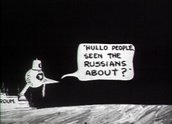

Cartoons of the Moment – German Dove of Peace (1915)
Synopsis
In this edition of Cartoons of the Moment from 1915, cartoonist Harry Julius uses cut-out and drawn animation to: comment on Germany’s offer of peace during the First World War; take a satirical look at the evolution of women’s fashions; and show Russia’s involvement in the war.
Curator’s notes
Cartoons have the power to distil many complex points in a single image, or series of images in the case of animation. Cartoons of the Moment succinctly draws together many strands of thought into a series of animated sketches that satirise the evolving political situation during the First World War. Harry Julius was employed by the Australasian Gazette to create Cartoons of the Moment, which ran at the end of wartime editions of the newsreel. The cartoons supported the Gazette’s recruitment drive for Australian troops, and in sketches from 1916 onwards, these became more and more persuasive by depicting the German forces as barbaric, murderous and a threat to the Australian way of life. Julius’s animated cartoons also occasionally provided social commentary on domestic issues that did not have to do specifically with the war (see clip one on the evolution of the skirt).
Cartoons of the Moment employs paper cut-outs – white figures on a dark background. Cut-out animation uses two-dimensional character shapes, photographed with a stop-motion technique. Stop-motion, or frame-by-frame photography, involves photographing the action one frame at a time to create the effect of movement. Today, animation is more often achieved using computer technology.
This wartime series was probably the first example of locally-produced animated cartoons being screened on a weekly basis to Australian audiences. Political cartoons in print have a long tradition in Australia dating back to the mid-19th century. The first news magazine to feature political cartoons was The Bulletin, which began publication in 1880. Harry Julius drew for the magazine in the early decades of the 20th century.
- Overview
- Curator’s notes
- Video 2 clips

- Find a copy
- Make a comment
- Add your review



